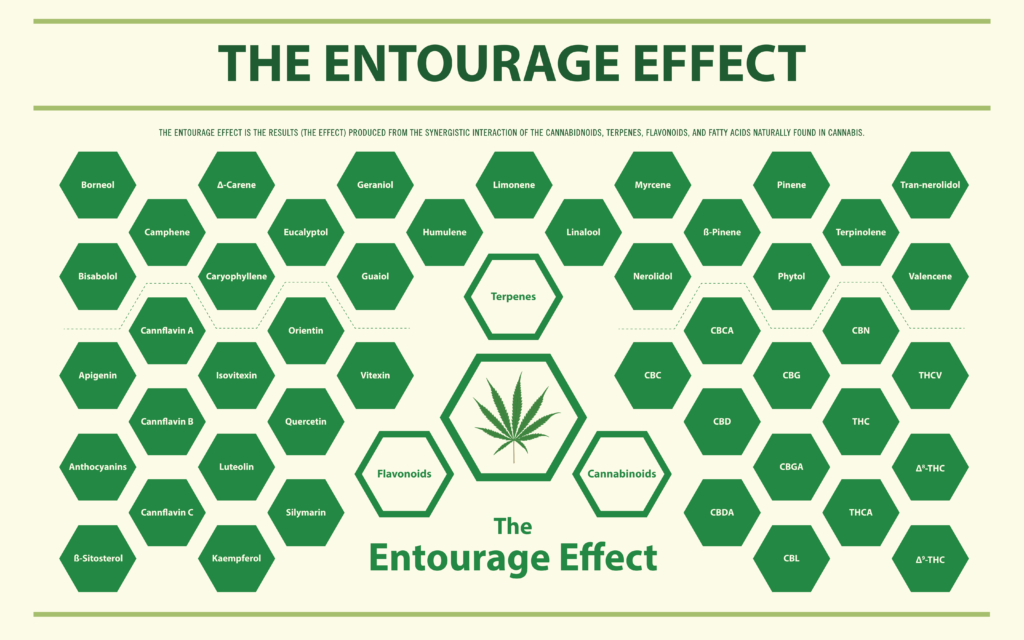Cannabis, like many other plants, is complex in terms of its biologic structure and the way that some of its compounds interact with the human body. Because marijuana is not yet federally legal in the United States, it can be challenging for researchers and scientists to launch studies to better understand the effects the components of the plant like cannabinoids, terpenes, and flavonoids have on the human body, as well as how they engage with the Endocannabinoid System (ECS).
While today’s consumers are highly interested in the potential health benefits that are associated with cannabis today, they might not be well versed in the terms that many in the industry use to describe the impact that cannabis can have on our health and well-being. One of the terms frequently used is “Entourage Effect.” Here, we break down what the term means, the elements that influence it, research studies on it, and how the concept impacts infused product development decisions.
Entourage Effect: A Working Definition
The term Entourage Effect refers to the synergistic relationship the plant’s compounds have with each other. In other words, some scientists believe that when the cannabinoids, terpenes, and flavonoids work in harmony, the result can be greater or better than if they were acting alone.
In 1998, Israeli scientists Raphael Machoulam and Simon Ben-Shabat first coined the term to describe the co-acting relationship that molecules can have on one another. They were studying the molecule 2-AG which binds to the CB1 and CB2 cannabinoid receptors in mice. What they discovered was that two other compounds improved 2-AG’s ability to bind to the receptors even though the two could not bind to the receptors themselves.
Dr. Ethan Russo, a neurologist who has spent much of his career studying cannabis, describes the concept as “botanical synergy” — where a dominant molecule like CBD or THC is supported by other plant substances like terpenes and flavonoids to achieve the maximum effect.
Another way to interpret this term is the following: “The whole is greater than the sum of its parts.” In the case of cannabis, some scientists argue that a cannabinoid’s efficacy can be heightened when it is paired with another part of the plant, such as other cannabinoids and terpenes.
The Elements That Influence the Entourage Effect
Cannabinoids
Cannabinoids are the “naturally occurring, biologically active, chemical constituents of hemp and cannabis.” They are also called phytocannabinoids in that they mimic the cannabinoids the body produces called endocannabinoids. Cannabinoids are produced by the hemp or cannabis plant’s trichomes; the plant begins to develop trichomes when flowers begin to form. The most common cannabinoids produced by the cannabis plant are CBD and THC, but there are other cannabinoids, sometimes called minor cannabinoids, like CBC, CBG, CBN, and THCv that are rising to prominence because of their purported health benefits.
Terpenes
Terpenes are the fragrant oils produced and secreted from the same glands that produce cannabinoids, the trichomes, that can repel predators and attract pollinators. They are the molecules that give the plant its odor and flavor and increase the cannabinoids’ efficacy. They also have antioxidant effects. There are over 200 terpenes in the cannabis plant, and each strain has its own unique blend of terpenes. Terpenes are the basis of aromatherapy, a healing treatment that utilizes a plant’s essential oils to promote physical and emotional well-being.
Terpenes have therapeutic qualities; they can play a role in a plant’s medicinal effects because of the way they interact with cannabinoids and help them enter the bloodstream. Scientists have found that when terpenes and cannabinoids work synergistically, they are potentially more effective in the treatment of pain, inflammation, anxiety, depression, epilepsy, and infection.
Research Studies on the Entourage Effect
Since 1998 when researchers Machoulam and Ben-Shabat first reported their findings, the research community has pursued studies of cannabinoids to further explore the Entourage Effect and whether or not compounds in the plant do (or don’t) work together to bolster a cannabinoid’s effectiveness.
In 2010, Dr. Ethan Russo published a paper entitled “Taming THC: Potential Cannabis Synergy and Phytocannabinoid-Terpenoid Entourgage Effect.” In his research, Russo had been focused on examining the interactions between cannabinoids and terpenes specifically. When discussing the relationship between cannabinoids, Russo states that CBD regulates the “psychoactivity of THC and reduces its adverse event profile.” In the latter portion of the paper, he explains how terpenes can enhance or minimize the effects of cannabinoids, such as pinene, which can counteract short-term memory deficits associated with THC.
In 2020, The journal Current Neuropharmacology published a paper by a group of scientists entitled, “The Entourage Effect: Terpenes Coupled with Cannabinoids for the Treatment of Mood Disorders and Anxiety Disorders.” The paper reviewed various papers covering the Entourage Effect in an attempt to answer the question, “When paired with terpenes, are cannabinoids more effective in treating some psychiatric symptoms?” They conclude that terpenes’ “contribution to the therapeutic effect of cannabinoids may be significant,” and that further research needs to be pursued to verify this – particularly in the realm of the relationship between terpenes and CBD in the treatment of patients suffering from anxiety, depression, or bipolar disorder.
The Entourage Effect’s Impact on Product Development
When product developers consider the type of infused product they are going to make and its desired effect, the Entourage Effect is something that should be taken into account, for it will impact whether or not they choose a Full-Spectrum, Broad-Spectrum or Isolate for their infused product.
Full-Spectrum means the maximum amount of helpful native phytochemicals are retained during extraction, including THC. The goal is to retain an identical ratio of cannabinoids, terpenes, and flavonoids from the original plant material
Broad-Spectrum retains a large complement of phytochemicals without the THC. Hemp is the basis for most Broad Spec extracts. Broad Spectrum can also be created by either adding terpenes, flavonoids, and minor cannabinoids to CBD isolate or by removing THC from Full Spectrum extract through distillation.
Isolate is the purest form of extracted cannabinoids, a crystalline powder with a purity of 99.9%.
Choosing between Full-Spectrum, Broad-Spectrum or Isolate reflects a brand’s understanding of the market and what their consumers value. For some, isolates are desirable because they allow producers to standardize their products based on known, reliable effects. However, for the more wellness-focused, the benefits of a wider complement of phytochemicals are worth the variability in the sensory experience and the effects. If you are a product developer interested in the Entourage Effect and are exploring water-soluble Broad-Spectrum emulsions for your infused product, book a call with the SōRSE team today to learn more about our product offerings.
Let’s Chat
Want to evaluate our emulsions? We’d love to learn more about your business and work to create a custom solution.
Tell us a little about yourself and we’ll be in touch shortly.
Privacy Policy. All rights reserved 2021.

Let’s Chat
Want to evaluate our emulsions? We’d love to learn more about your business and work to create a custom solution.
Tell us a little about yourself and we’ll be in touch shortly.
Privacy Policy. All rights reserved 2021.

Let’s Chat
Want to evaluate our emulsions? We’d love to learn more about your business and work to create a custom solution.
Tell us a little about yourself and we’ll be in touch shortly.
Privacy Policy. All rights reserved 2021.

A
better
emulsion
Here is our step-by-step guide on water-soluble emulsion technology’s impact on stability.


